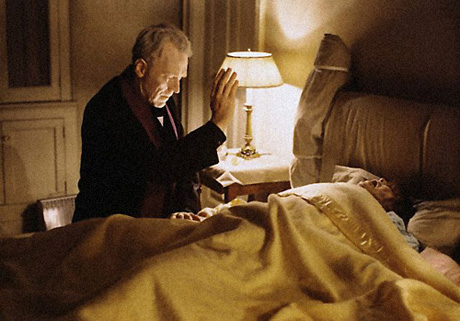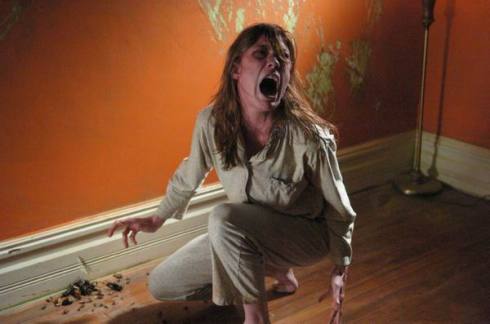Possessions are often refuted by the Catholic Church as a practice abandoned many centuries ago, once psychology surfaced as a viable explanation for the condition of mental illness that has afflicted many people. We can see it today, where psychological ailments are diagnosed and fits of psychosis are linked with misfiring neurons rather than assessed through spiritual or metaphysical inquiries. This is more likely due to the dismissal of faith as tangible and directed towards an acceptance of psychology as scientific proof. Such inquiries are evidenced throughout many mediums, but none have the same audio-visual quality of cinema. The most readily accepted format of entertainment has become the medium of exploration and questioning of such ideas of science and faith. Possession films are often a subgenre that tackles both aspects that surrounds the human condition often leaving us in a state of ambiguity, where neither side is right or wrong. ‘The Exorcist’ and ‘The Exorcism of Emily Rose’ represent a spectrum of change in the “possession film” in which, narrative (spirituality and film style); perception (special effects and violence) and relevancy (box-office and pop-culture), contribute to the differences and similarities of this subgenre and its audiences.
When assessing the similarities and differences in both ‘The Exorcist’ and ‘The Exorcism of Emily Rose’, it’s largely perceived in the way that they speak of spirituality. The rejection of religion by Chris MacNeil, a highly successful Hollywood actress and single mother, in ‘The Exorcist’ led to her daughter’s possession by the demon Pazuzu (king of the wind demons) and finally her acceptance that her neglect allowed demons to enter the weakened body of her daughter. Pazuzu also is thought to cause harm to both mother and daughter during childbirth, Chris only having one daughter would be the allusion of the entrance of this demon. In ‘The Exorcism of Emily Rose’ Erin Bruner a successful lawyer, adamant about the existence of God, defends Father Moore after he’s accused of killing Emily Rose during the exorcism of her six demons. The similarity of two successful working women with an objection to God, are surrounded by the apparent horrors they bring amongst themselves.Erin begins pondering the conflict between her oath to the court and the beginnings of her experiences with strange occurrences at 3AM. Often referred to as “the witching hour”, where lore holds that demons mock the Holy Trinity at this specific hour because, Jesus is often thought to have died at 3PM.
The films themselves also slightly differ in their film style. ‘The Exorcism of Emily Rose’ plays the “exorcism” as a flashback, informing audiences in a courtroom style narrative of unfolding events. As the murder trial begins to unfold, we’re left to follow a path that Erinbegins to identify: the possibility that demons exist and the need for faith in something is necessary to fight off evil in whatever incarnation they may appear. In ‘The Exorcist’, the film allows the playful nature of participative and passive interaction between viewers and Chris MacNeil (the mother) accepting the growing horrific reality that demons, and therefore faith, are the cause of Regan’s afflictions and aren’t psychological or medical ailments. George Edward Woodberry once said “If you can’t have faith in what is held up to you of faith, you must find things to believe in yourself, for a life without faith in something is too narrow a space to live.” Herein lies the crux that both plagues Chris MacNeil and Erin Bruner, where their perception of faith allowed entrances of demons and that when they accept their presence, they can begin to live without fear.

At just over 30 years difference between ‘The Exorcist’ and ‘The Exorcism of Emily Rose’, there’s the growing change in depiction of violence and in special effects. As seen with ‘The Exorcist’, it was often thought as an extreme portrayal of violence especially when concerned with using a child for many of the stunts. The violence was a manifestation towards the disruption of normalcy as well as violent physicality between the demon and the people who would challenge his presence. When we first see the demon Pazuzu manifesting itself, it was concerned with unsettling the people who mattered most when choosing Regan as its host. Those people were Chris MacNeil (Regan’s mother) and Father Karras (who later forced the demon into his own body so that he’d save Regan); by having a possessed Regan physically strike them both making them seem weak and helpless. In ‘The Exorcism of Emily Rose’ similar physicality is demonstrated as Emily Rose begins on path of heightened contortion and body movement. As the possession of Emily Rose’s body progresses, the more the demon utilizes her body as a vessel, contorting the human body into position that aren’t natural with a malleability to his will, and he also creates a stiffness and abuse of the body as he see’s fit. What’s interesting to note is that the demon possessing Emily Rose moved around with Emily Rose causing more physicality and extreme conditions surrounding her whereas, Regan (when possessed) was confined to her bedroom while the adults around her moved in and out of the bedroom. Also, the possession of Regan and Emily are representative of Chris and Erin’s choice at limiting the morality of religion in today’s apathetic and conflicted compliance to have faith.
What’s also intriguing is the use of special effects in the portrayal of demon possession in these young women. With ‘The Exorcist’, Regan is dressed in makeup and hooked to prosthetic pieces to convince audiences of a very toned and realist portrayal of possession. Regan’s increasing make-up made the progression of her possession more evident and having a thin tube attached to the inside of her mouth to allow a practical oozing of vomit (infamous pea-green soup) coming from her mouth; a queasy scene where Regan is put through a carotid angiography and the recently re-inserted spider-walk scene (for the Director’s cut on DVD). These effects are all practically performed with prosthetics, harnesses and make-up and therefore have some differing ambitions than the digital effects in ‘The Exorcism of Emily Rose’. One of the most notable sequences includes Emily walking outside in the middle of the night, after being startled by the increasing presence of her demon possessors, envisioning the people around her with demonic faces that quickly resemble decayed versions of Edvard Munch’s “The Scream” and the dilation of Emily’s pupils to symbolize her possession. Again, the ambitions do increase with digital effects, but ‘Emily Rose’ does keep most of the physicality and effects practical by use of various equipment. Both films utilize these special effects to symbolize the struggle that plagues the exorcizing of demons from these young girls and to unnerve the viewers with a realistic portrayal of the exhaustive nature that the process takes.
Intriguingly enough, the lasting effects that both films have on audiences wildly differ mainly due to the amount of time that the films have been able to have concerning “shock value” and questions about “science and faith”. Having the biggest box-office cume as an R-rated film, ‘The Exorcist’ has cemented itself in pop-culture by its audacious ability (in the 70s) to terrify and intrigue audiences by it’s vulgarity, as well as its questioning what faith and science can offer individuals. The biggest statement that ‘The Exorcist’ makes is whether psychology has replaced religion due to the decreasing influence of the church and the rising need of empirical evidence and a philosophical skepticism. ‘The Exorcism of Emily Rose’ deters the trend set in ‘The Exorcist’ when the debate between science and faith becomes the focus when Father Moore on trial for the murder of Emily Rose. Although having a very decent box-office cume, it represented the last “possession” film to remarkably and creatively re-invent the genre as there hasn’t been a film since then to create lasting impressions.
Both ‘The Exorcist’ and ‘The Exorcism of Emily Rose’ propagate differences and similarities that clearly attribute their importance and relevancy back in the 70s and 2000s when spirituality became highly dependent as a consequence for our acceptance or rejection in science; when our participative and passive interaction with the concept of possession as possible truth; when the special effects are highly dependent on budgetary allowance and purpose for the film to portray a gritty, yet realistic display or a slick and clean demonstration is an escape viewers wish to accept; when its portrayal of violence as pain is to symbolize where faith is concerned or shocking as to unnerve audiences; when that profitability at the box-office becomes primary evidence by its inferred statement that audiences are affected spiritually, physically or psychologically and finally when its reception and interpretation that’s founded on realism that psychology replaces religion or the idea that religion and psychology can co-exist; when all is to indicate that its perception is dependent on the openness of the reader.



